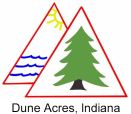Natural Landscaping in Dune Acres
Diverse Ecological Communities
Within the Town, you'll find a range of ecological communities, each with its unique attributes. These encompass the beach, adorned with marram grass, sand cherry, juniper, and cottonwood; the high dunes boasting black oak, puccoon, lupine, and showy goldenrod—plants that thrive in sandy, sun-drenched environments. Venture to the north slope back dunes to encounter white and red oaks, witchhazel, and shadblow. In low coves, white oaks, sugar maple, may apples, dogwood, and ferns flourish. Your property likely aligns with one of these categories. Some exceptionally rare plants flourish within town parks and residential properties in Dune Acres, possibly on yours. We aim to identify and preserve these treasures with property owners' help.
A Generational Vision for Land Preservation and StewardshipEven before its founding, “Mineral Springs” (as the Dune Acres area was known prior to 1923) was a destination for scientists and nature enthusiasts. The most notable was University of Chicago professor Henry Chandler Cowles, whose namesake “bog" is the most famous natural area in Dune Acres. Overt time, Dune Acres has devoted more than 270 acres of land to town parks, at times requiring substantial financial contributions from its residents. Most of the town's parkland is maintained as natural areas to preserve the native flora and fauna found here.
Embracing Nature's BeautyWhile many envision yards as expanses of lawn dotted with marigolds and imported evergreens—a quintessential American suburban landscape—native dunes vegetation holds a captivating allure. Most residents work to maintain this indigenous flora as an integral part of their landscaping. This approach offers several benefits; these plants are naturally suited to the area's dry, sandy, and often windy conditions, requiring minimal upkeep once established. Moreover, retaining native vegetation helps to preserve privacy and protect the delicate sand dunes from erosion.
The Flourishing Concept of Natural LandscapingThe concept of natural landscaping is gaining momentum in many places, including Northwest Indiana. In many cases, commercial landscape designers and contractors have yet to acquire substantial knowledge or interest in native plants. Be vigilant and firm when dealing with any designer, contractor, or garden center. A good rule of thumb is to demand only plants found on or immediately adjacent to your own property.
Preserving Your Landscape's EssenceSafeguarding your existing vegetation is much simpler, and less expensive, than restoring it. Before undertaking any significant site improvements, take time to acquaint yourself with the plants on your property across changing seasons. The inconspicuous small tree you contemplate removing during winter could transform into a resplendent flowering dogwood come spring.
Mitigating Invasive SpeciesMany invasive plant species present in Dune Acres were initially introduced as part of ornamental landscaping for residential properties. Over time, these thuggish plants have proven problematic, gradually eradicating native vegetation. Among these are black locust, several specie of bush and vining honeysuckles, purple loosestrife, multiflora rose, Russian-olive, Asian bittersweet, Japanese barberry, and tree of heaven. Please exercise extreme caution in preventing such plants from infiltrating our community.
ResourcesA wealth of resources is available for those seeking additional information about the flora of the Indiana Dunes and best practices for stewardship. You may find print versions of some of these informative publications at town hall."
Natural Landscaping in Dune Acres — In this colorful brochure, learn about native plant communities, find inspiration for your property, and uncover the legacy of stewardship in Dune Acres.Save the Dunes — Link to the Save the Dunes website which includes downloadable guides for "Living in the Dunes." These publications were designed for residents of Dune Acres and other shoreline communities.
An Open Letter to Homebuilders — Inspiration and guidance, intended especially for new property owners and prospective homebuilders.
Building Inside Nature's Envelope — An indispensable guide for property owners who wish to build in Dune Acres. Gain inspiration to safeguard the natural features that make our town distinct, along with advice on preserving desirable vegetation from the effects of construction.
Invasive Plants of Indiana: Pretty Awful! — An informative publication produced by the Indiana Invasive Species Council. It includes many invasive plant species that are found in Dune Acres. Indiana Invasive Species Council – Official Invasive Plant List — This list, updated periodically, details trees, shrubs, and plants that are officially classified as "invasive" per Federal Executive Order 13751, Safeguarding the Nation from the Impacts of Invasive Species. The plants on this list are prohibited from introduction to Dune Acres. They cannot be planted or transplanted in the town.
